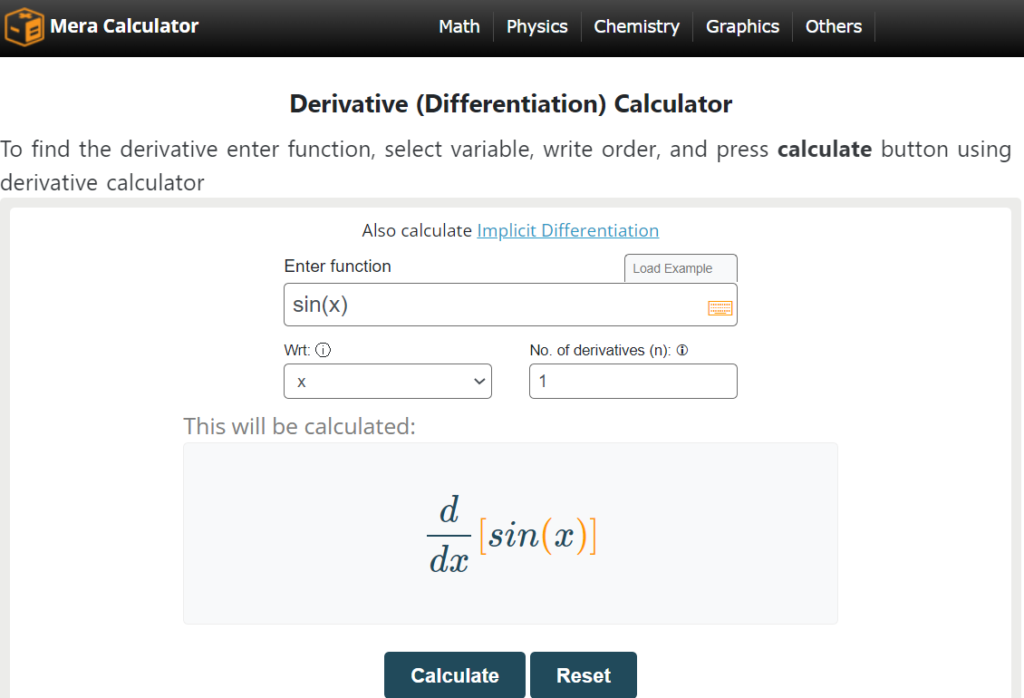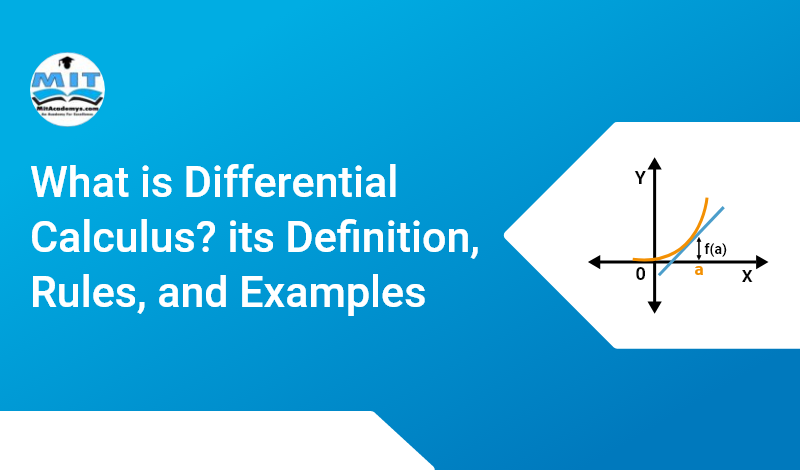Calculus is a branch of mathematics that deals with rates of change and curvature of functions. Derivative (Differential) calculus is a subfield of calculus that deals with the study of derivatives. In other words, it’s the study of how a function changes when its inputs are changed.
In this blog post, we’ll break down everything you need to know about derivative (Differential) calculus. Derivatives are a key part of the calculus, and they play an important role in many areas of mathematics.
In this section, we will provide a brief introduction to derivatives, and discuss their definition, rules, types, and examples.
What Is a Derivative (Differential)?
A derivative is simply a mathematical term for the rate of change of a function. It can be thought of as the slope of the function, and it describes how quickly the function changes over time.
Derivative calculus is the study of derivatives, which are rates of change of functions. This can be used to find out how a function changes as its input changes. Derivatives can also be used to find local minimums and maximums, points of inflection, and extreme points.
There are many types of derivatives that correspond to different ways in which functions change over time: linear derivatives (which describe slopes that stay relatively constant), quadratic derivatives (which describe slopes that become steeper as they increase), and exponential derivatives (which describe slopes that increase exponentially with time).
Each type of derivative has its own specific rules for calculating it. These types of derivative calculus.
- Explicit derivative
- Implicit derivative
- Partial derivative
Let us discuss these types briefly
Explicit Derivative
The explicit derivative is used to evaluate the derivative of a single variable function and is denoted by d/dx, d/dy, d/dz, etc. It is the most prominent type of derivative.
Implicit Derivative
The implicit derivative is used to evaluate the derivative of an equation like f(x, y) = g(x, y). In this type of differential calculus, the derivative of an independent variable with respect to the dependent variable never be zero. It will be written as d/dx (y2) = 2y dy/dx.
The basic of this type is to evaluate the differential of the dependent variable with respect to the independent variable without considering it constant.
Partial Derivative
A partial derivative is used to find the derivative of a multivariable function like f(x, y, z). It finds the derivative of the multivariable function with respect to any dependent variable. It is denoted by ∂/∂x, ∂/∂y, ∂/∂z, etc.
Such as ∂/∂x [f(x, y, z]
Derivatives are one of the most important concepts in calculus, and they play a major role in many other fields as well. For example, if you want to find the slope of a line, then you need to know both the derivative of y with respect to x and the derivative of x with respect to y.
In engineering, derivatives are often used when designing machines or making decisions about how something will behave in certain situations. So derivatives are definitely worth getting acquainted with!
Rules of Differentiation
Below are the basic rules/laws of differentiation. These rules play a vital role in the calculation of differential problems.
| Rules name | Rules |
| Trigonometry Rule | d/dt [sin(t)] = cos(t) d/dt [cos(t)] = -sin(t) d/dt [tan(t)] = sec2(t) |
| Power Rule | d/dt [f(t)]n = n [f(t)]n-1 * [f’(t)] |
| Quotient Rule | d/dt [f(t) / g(t)] = 1/[g(t)]2 [g(t) * [f’(t)] – f(t) * [g’(t)]] |
| Product Rule | d/dt [f(t) * g(t)] = g(t) * [f’(t)] + f(t) * [g’(t)] |
| Constant Rule | d/dt [L] = 0, where L is any constant |
| Difference Rule | d/dt [f(t) – g(t)] = [f’(t)] – [g’(t)] |
| Sum Rule | d/dt [f(t) + g(t)] = [f’(t)] + [g’(t)] |
| Exponential Rule | d/dt [et] = et d/dt [t] |
| Constant function Rule | d/dt [L * f(t)] = L [f’(t)] |
How to calculate differential calculus?
The derivative of functions can be taken either by using the first principle method or by using the rules of differentiation. A derivative calculator by Meracalculator (https://www.meracalculator.com/math/derivative.php) can also be used to solve differential calculus problems to avoid time-consuming calculations.

Here are examples of calculating the derivative of the function.
Example 1: By the first principle method
Evaluate the derivative of the given algebraic expression with respect to “t”.
f(t) = 21t3 – 12t – 36
Solution
Step 1: First of all, write the general expression of the first principle method.
d/dt [f(t)] = limh→0 [f(t + h) – f(t)] / h
Step 2: Now take the given function and add “h” to the independent variable of the function.
f(t) = 21t3 – 12t – 36
f(t + h) = 21(t + h)3 – 12(t + h) – 36
f(t + h) = 21[t3 + h3+ 3th(t + h)] – 12(t + h) – 36
f(t + h) = 21[t3 + h3+ 3t2h + 3th2] – 12(t + h) – 36
f(t + h) = 21t3 + 21h3+ 63t2h + 63th2 – 12t – 12h – 36
Step 3: Now substitute the values in the general expression of the first principle method
d/dt [21t3 – 12t – 36] = limh→0 [21t3 + 21h3+ 63t2h + 63th2 – 12t – 12h – 36] – [21t3 – 12t – 36] / h
= limh→0 [21t3 + 21h3+ 63t2h + 63th2 – 12t – 12h – 36 – 21t3 + 12t + 36] / h
= limh→0 [21t3 + 21h3+ 63t2h + 63th2 – 12t – 12h – 36 – 21t3 + 12t + 36] / h
= limh→0 [21h3+ 63t2h + 63th2 – 12h] / h
= limh→0 [h(21h2+ 63t2 + 63th – 12)] / h
= limh→0 [h(21h2+ 63t2 + 63th – 12)] / h
= limh→0 (21h2+ 63t2 + 63th – 12)
Apply the limit value.
= limh→0 (21h2)+ limh→0 (63t2) + limh→0 (63t*h) – limh→0 (12)
= (21(0)2)+ (63t2) + (63t*(0)) – (12)
= 0+ 63t2 + 0 – 12
= 63t2 – 12
Example 2: By using the laws
Evaluate the derivative of the given algebraic expression with respect to “u”.
f(u) = 21u2 – 15u + 12u4 + 16u3 * 16u2
Solution
Step 1: First of all, take the given algebraic expression and apply the differentiation notation to it.
f(u) = 21u2 – 15u + 12u4 + 16u3 * 16u2
d/dt f(t) = d/dt [21u2 – 15u + 12u4 + 16u3 * 16u2]
Step 2: Apply the sum and difference rules of differentiation to write the differential notation with each function separately.
= d/dt [21u2] – d/dt [15u] + d/dt [12u4] + d/dt [16u3 * 16u2]
Step 3: Apply the differentiation rule of the product.
= d/dt [21u2] – d/dt [15u] + d/dt [12u4] + [16u3 * d/dt (16u2) + 16u2 d/dt (16u3)]
= d/dt [21u2] – d/dt [15u] + d/dt [12u4] + 16u3 * d/dt (16u2) + 16u2 d/dt (16u3)
Step 4: Now apply the constant function rule of differentiation.
= 21d/dt [u2] – 15d/dt [u] +12 d/dt [u4] + 256u3 * d/dt (u2) + 256u2 d/dt (u3)
Step 5: Now differentiate the above expression with the help of the power rule.
= 21 [2u2-1] – 15 [u1-1] + 12 [4u4-1] + 256u3 * (2u2-1) + 256u2 (3u3-1)
= 21 [2u1] – 15 [u0] + 12 [4u3] + 256u3 * (2u1) + 256u2 (3u2)
= 21 [2u] – 15 [1] + 12 [4u3] + 256u3 * (2u) + 256u2 (3u2)
= 42u – 15 + 48u3 + 512u4 + 768u4
= 42u – 15 + 48u3 + 1280u4
= 1280u4 + 48u3 + 42u – 15
Final Words
Now you are witnessed that calculating the problems of differential calculus is not a difficult task. You can get help from this post to perform the calculations. We have covered the definition, explanation, rules, and solved examples of derivatives in this post.











































































































































